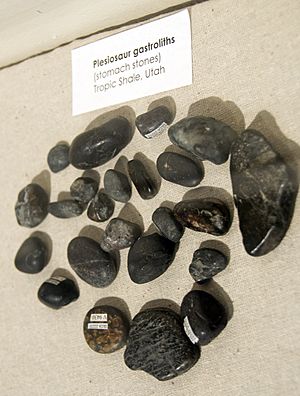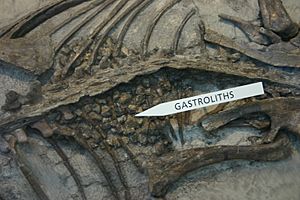Gastrolith facts for kids


Gastroliths, also known as gizzard stones, are small rocks that some animals keep inside their stomach or in the first part of their digestive system. These special stones help animals mash up their food, which makes digestion happen faster. Animals that use gastroliths often don't have strong enough teeth to grind their food properly. So, gastroliths act like a substitute for teeth.
For animals that live in water, like some seals or crocodiles, gastroliths have another important job. They can act as ballast, which means they add weight. This extra weight helps these animals dive deeper and stay underwater more easily.
How Scientists Identify Gastroliths
Scientists need a few clues to figure out if a rock was used by an ancient animal as a gastrolith.
First, the stone should look different from other rocks found nearby. This suggests the animal picked it up from somewhere else.
Second, a real gastrolith should be smooth and rounded. Inside an animal's stomach, the stones rub against each other and the food, just like rocks in a rock tumbler. This constant rubbing makes them polished over time.
Finally, the stone must be found very close to the fossils of the animal that swallowed it. This helps scientists be sure the animal actually used the stone.
Animals That Use Gastroliths
Many different animals, both living and extinct, use gastroliths.
Among animals alive today, you can find gastroliths in crocodiles, alligators, and plant-eating birds. Seals and sea lions also use them. Farm animals like chickens (domestic fowl) need small stones, often called 'grit', to help them digest their food. Large birds like ostriches can swallow stones that are over 10 centimeters long! Even some amphibians, like the Axolotl, swallow rocks that are thought to be gastroliths. Tiny gastroliths have also been found in frog tadpoles, helping them control how they float in water.
Long ago, huge plant-eating sauropod dinosaurs likely used gastroliths to grind up tough plants. For example, a dinosaur called Caudipteryx zoui was found with small stones in its stomach area. Water-dwelling dinosaurs, like plesiosaurs, might have used gastroliths as ballast, similar to how crocodiles do today. This would have helped them balance or sink in the water. While some fossil gastroliths are very smooth, many stones found in living birds are not polished at all. Some gastroliths found with dinosaur fossils can weigh several kilograms!
Images for kids
-
A diplodocid dinosaur swallowing gastroliths along with the plants it is eating.
See also
 In Spanish: Gastrolito para niños
In Spanish: Gastrolito para niños



